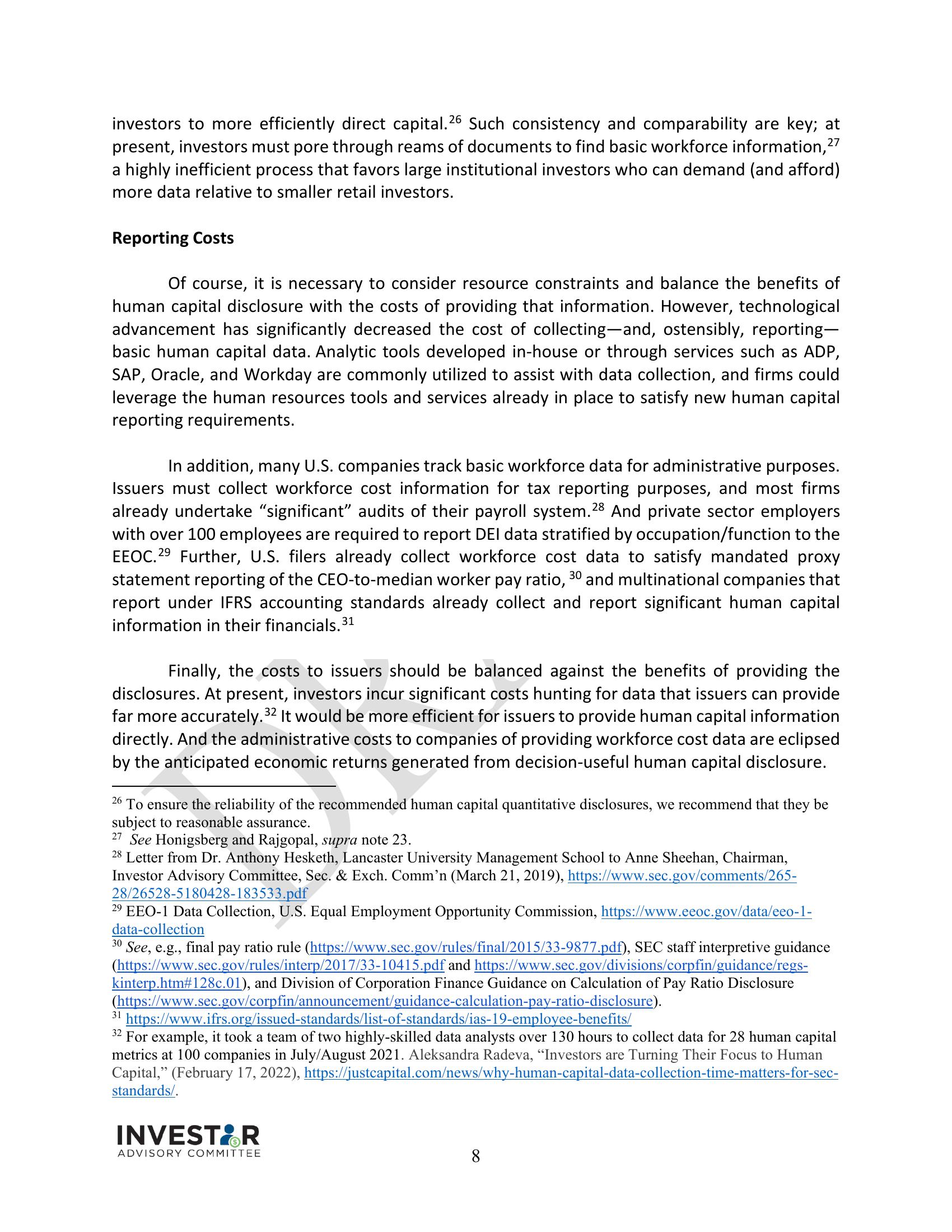Workforce Data Insight Pitch
investors to more efficiently direct capital. 26 Such consistency and comparability are key; at
present, investors must pore through reams of documents to find basic workforce information, 27
a highly inefficient process that favors large institutional investors who can demand (and afford)
more data relative to smaller retail investors.
Reporting Costs
Of course, it is necessary to consider resource constraints and balance the benefits of
human capital disclosure with the costs of providing that information. However, technological
advancement has significantly decreased the cost of collecting-and, ostensibly, reporting-
basic human capital data. Analytic tools developed in-house or through services such as ADP,
SAP, Oracle, and Workday are commonly utilized to assist with data collection, and firms could
leverage the human resources tools and services already in place to satisfy new human capital
reporting requirements.
In addition, many U.S. companies track basic workforce data for administrative purposes.
Issuers must collect workforce cost information for tax reporting purposes, and most firms
already undertake "significant" audits of their payroll system. 28 And private sector employers
with over 100 employees are required to report DEI data stratified by occupation/function to the
EEOC. 2⁹ Further, U.S. filers already collect workforce cost data to satisfy mandated proxy
statement reporting of the CEO-to-median worker pay ratio, 30 and multinational companies that
report under IFRS accounting standards already collect and report significant human capital
information in their financials. 31
Finally, the costs to issuers should be balanced against the benefits of providing the
disclosures. At present, investors incur significant costs hunting for data that issuers can provide
far more accurately. 32 It would be more efficient for issuers to provide human capital information
directly. And the administrative costs to companies of providing workforce cost data are eclipsed
by the anticipated economic returns generated from decision-useful human capital disclosure.
26 To ensure the reliability of the recommended human capital quantitative disclosures, we recommend that they be
subject to reasonable assurance.
27 See Honigsberg and Rajgopal, supra note 23.
28 Letter from Dr. Anthony Hesketh, Lancaster University Management School to Anne Sheehan, Chairman,
Investor Advisory Committee, Sec. & Exch. Comm'n (March 21, 2019), https://www.sec.gov/comments/265-
28/26528-5180428-183533.pdf
29 EEO-1 Data Collection, U.S. Equal Employment Opportunity Commission, https://www.eeoc.gov/data/eeo-1-
data-collection
30 See, e.g., final pay ratio rule (https://www.sec.gov/rules/final/2015/33-9877.pdf), SEC staff interpretive guidance
(https://www.sec.gov/rules/interp/2017/33-10415.pdf and https://www.sec.gov/divisions/corpfin/guidance/regs-
kinterp.htm#128c.01), and Division of Corporation Finance Guidance on Calculation of Pay Ratio Disclosure
(https://www.sec.gov/corpfin/announcement/guidance-calculation-pay-ratio-disclosure).
31 https://www.ifrs.org/issued-standards/list-of-standards/ias-19-employee-benefits/
32 For example, it took a team of two highly-skilled data analysts over 130 hours to collect data for 28 human capital
metrics at 100 companies in July/August 2021. Aleksandra Radeva, "Investors are Turning Their Focus to Human
Capital," (February 17, 2022), https://justcapital.com/news/why-human-capital-data-collection-time-matters-for-sec-
standards/.
INVESTOR
ADVISORY COMMITTEE
8View entire presentation